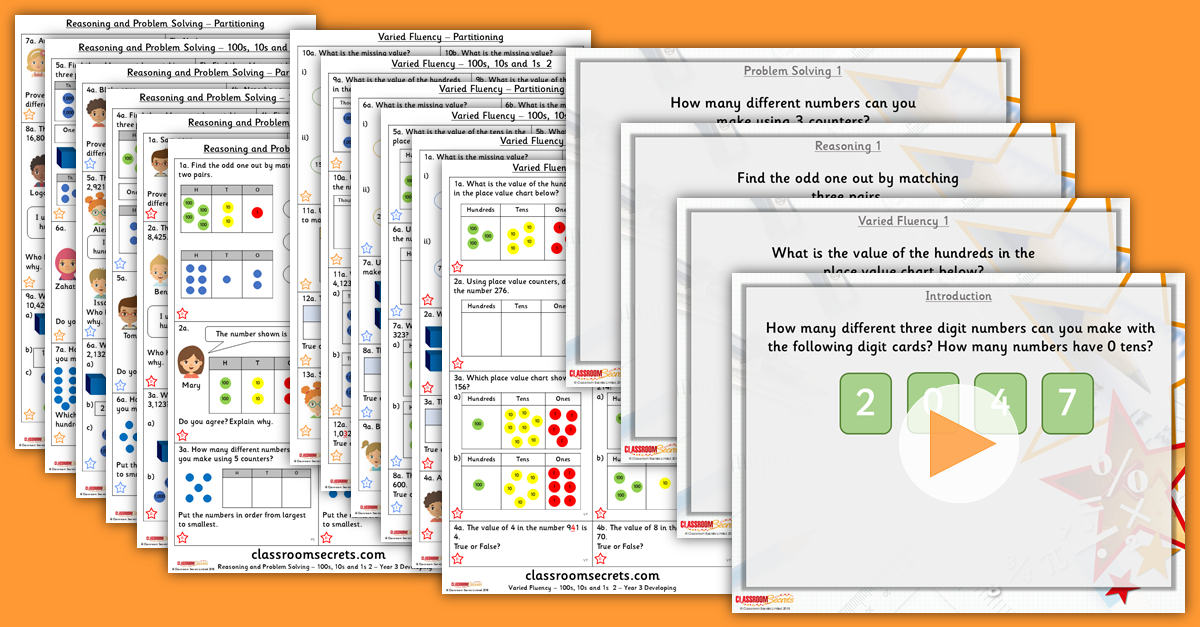Mixed Age Year 3 and 4 Place Value Step 4 Resource Pack

Mixed Age Year 3 and 4 Place Value Step 4
Mixed Age Year 3 and 4 Place Value Step 4 Resource Pack includes a teaching PowerPoint and differentiated varied fluency and reasoning and problem solving resources for both year groups for Autumn Block 1 and covers Year 3 100s, 10s and 1s 2 & Year 4 Partitioning.
Not a member? Sign up here.
What's included in the Pack?
This Mixed Age Year 3 and 4 Place Value Step 4 pack includes:
- Mixed Age Year 3 and 4 Place Value Step 4 Teaching PowerPoint with examples for both year groups.
- 100s, 10s and 1s 2 Year 3 Varied Fluency with answers.
- 100s, 10s and 1s 2 Year 3 Reasoning and Problem Solving with answers.
- Partitioning Year 4 Varied Fluency with answers.
- Partitioning Year 4 Reasoning and Problem Solving with answers.
National Curriculum Objectives
Mathematics Year 3: (3N2a) Read and write numbers up to 1000 in numerals and in words
Mathematics Year 3: (3N3) Recognise the place value of each digit in a three-digit number (hundreds, tens, ones)
Mathematics Year 3: (3N6) Solve number problems and practical problems involving 3N1 - 3N4
Mathematics Year 4: (4N4a) Identify, represent and estimate numbers using different representations
Mathematics Year 4: (4N6) Solve number and practical problems that involve 4N1 - 4N5 and with increasingly large positive numbers
Differentiation for Year 3 100s, 10s and 1s 2:
Varied Fluency
Developing Questions to support representing 3-digit numbers using a place value chart and counters, without the use of zero as a placeholder.
Expected Questions to support representing 3-digit numbers using a place value chart and counters, with some use of zero as a place holder.
Greater Depth Questions to support representing 3-digit numbers using a place value chart and counters, with some use of zero as a place holder and unconventional partitioning.
Reasoning and Problem Solving
Questions 1, 4 and 7 (Reasoning)
Developing Using knowledge of place value, explain the odd one out by matching two different representations of 3-digit numbers, without the use of zero as a place holder.
Expected Using knowledge of place value, explain the odd one out by matching three different representations of 3-digit numbers, with some use of zero as a place holder.
Greater Depth Using knowledge of place value, explain the odd one out by matching four different representations of 3-digit numbers, with some use of zero as a place holder and unconventional partitioning.
Questions 2, 5 and 8 (Reasoning)
Developing Explain if the place value chart represents a given 3-digit number, without the use of zero as a place holder.
Expected Explain if the place value chart represents a given 3-digit number, with some use of zero as a place holder.
Greater Depth Explain if the place value chart represents a given 3 digit-number, with some use of zero as a place holder and unconventional partitioning.
Questions 3, 6 and 9 (Problem Solving)
Developing Using knowledge of place value, create numbers using up to 6 counters on a place value chart. The use of zero as a place holder is not expected.
Expected Using knowledge of place value, create numbers using up to 7 counters on a place value chart. Some use of zero as a place holder is expected.
Greater Depth Using knowledge of place value, create numbers using up to 8 counters on a place value chart. Some use of zero as a place holder is expected and unconventional partitioning.
Differentiation for Year 4 Partitioning:
Varied Fluency
Developing Questions to support exploring how numbers can be partitioned. Using 4-digit numbers and a variety of pictorial representations where each number has been partitioned once. Some use of unconventional partitioning.
Expected Questions to support exploring how numbers can be partitioned. Using 4-digit numbers and a variety of pictorial representations with some instances of multiple examples of unconventional partitioning within a number.
Greater Depth Questions to support exploring how numbers can be partitioned. Using 4-digit numbers and some pictorial representations including multiple examples of unconventional partitioning within a number where the parts are not given in place value order.
Reasoning and Problem Solving
Questions 1, 4 and 7 (Problem Solving)
Developing Find two different ways to partition a 4-digit number. Includes pictorial representations. Each number is partitioned once. Some unconventional partitioning.
Expected Find two different ways to partition a 4-digit number. Using some instances of multiple examples of unconventional partitioning within a number.
Greater Depth Find two different ways to partition a 4-digit number. Includes some pictorial representations. Multiple examples of unconventional partitioning within a number where the parts are not given in place value order.
Questions 2, 5 and 8 (Reasoning)
Developing Explain which statement partitions a 4-digit number correctly. Includes pictorial representations. Each number is partitioned once. Some unconventional partitioning.
Expected Explain which statement partitions a 4-digit number correctly. Using some instances of multiple examples of unconventional partitioning within a number.
Greater Depth Explain which statement partitions a 4-digit number correctly. Includes written representations with multiple examples of unconventional partitioning within a number, where the parts are not given in place value order.
Questions 3, 6 and 9 (Reasoning)
Developing Explain which partitioned representation does not show a given 4-digit number. Includes a variety of pictorial representations where each number has been partitioned once. Some use of unconventional partitioning.
Expected Explain which partitioned representation does not show a given 4-digit number. Includes pictorial and written representations. Using some instances of multiple examples of unconventional partitioning within a number.
Greater Depth Explain which partitioned representation does not show a given 4-digit number. Pictorial and written representations used. Multiple examples of unconventional partitioning within a number where parts are not given in place value order.
This resource is available to download with a Premium subscription.






